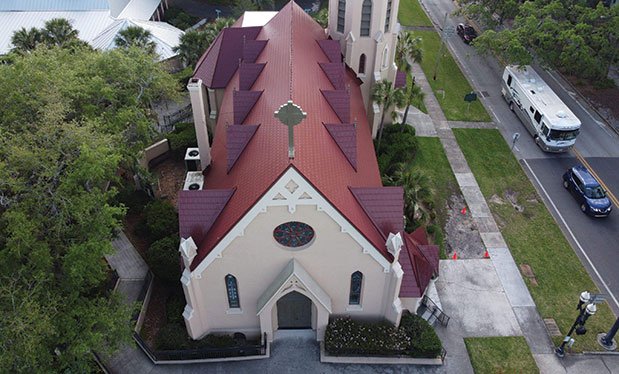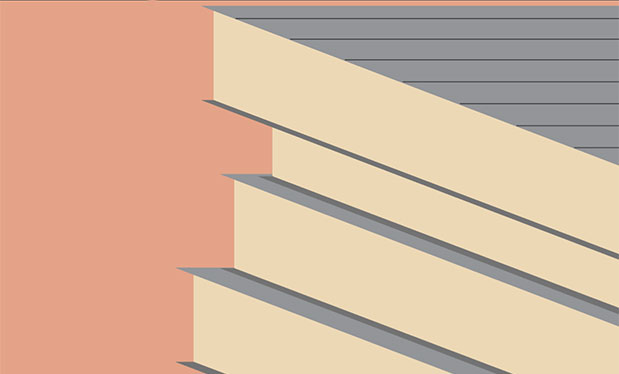
In the TV game show “Password,” which originally aired from 1961-75, a segment referred to as the lightning round addressed multiple questions and answers in a defined time. In 2023, NBC reintroduced “Password” with Jimmy Fallon as its host. But this month, I am your host for a roofing-specific lightning round.
Mop-applied SBS cap sheets
Until the early 2000s, SBS polymer-modified bitumen cap sheets commonly were installed using mop-applied hot asphalt, but the method often resulted in reports of membrane blistering. In January 1998, NRCA issued an interim report notifying its members of the blistering issue and offering interim recommendations. In the April 2000 and May 2000 issues of Professional Roofing, I reported about NRCA’s blistering research and offered blister-mitigation guidance.
Since then, the mop-applied installation method has fallen out of favor and been replaced with cold-applied adhesives. As adhesive technology and application techniques have advanced, adhesive application has become the preferred application method for SBS polymer-modified bitumen cap sheets.
However, following the COVID-19 pandemic and supply chain crisis, there has been renewed interest by some manufacturers and specifiers regarding the mop-applied hot asphalt installation method for SBS polymer-modified bitumen cap sheets.
The concerns for membrane blistering still exist, and NRCA’s previous cautions, research and blister-mitigation guidance still apply.
Fastener ads
Recently, some fastener suppliers’ advertisements have touted the availability of their fasteners and fastener plates for use as substitutions in FM Approvals-approved roof assemblies. I also am aware of situations where these suppliers have reached out directly to roof system manufacturers, other suppliers and distributors and roofing contractors offering their fasteners as substitutions for other approved fasteners and plates.
FM Approvals’ product approvals apply to specific products and their use in specific roof assemblies termed “RoofNav assemblies.”
Product substitutions (including substituting fasteners and plates) other than those identified in a specific RoofNav assembly number are unapproved substitutions and should be avoided.
Moisture meters
Handheld moisture-detection meters have decreased significantly in cost. One retailer is charging $13.95 for a basic, consumer-targeted device. The use and, unfortunately, misuse of these devices has become more widespread.
NRCA is receiving a significant number of reports where handheld moisture-detection meters are being used and representations are being made of excessive or unacceptable moisture content readings. In some instances, this has resulted in unnecessary concern for and rejection of roofing materials and products.
Handheld moisture-detection meters do not detect actual water or roofing materials’ moisture contents. Instead, most meters detect conductivity within the material being evaluated. Because water exhibits relatively good conductivity, high meter readings are claimed to indicate material wetness; however, many roofing materials also exhibit varying degrees of conductivity. Therefore, correlating conductivity to a material’s wetness leads to wrong conclusions.
When a device is used properly and calibrated to a specific material, it can indicate a material’s moisture content. Calibration to gypsum wall board and specific wood species of specific gravities is provided with some high-end, handheld moisture-detection meters. Using a meter’s moisture scale to determine moisture content of material compositions other than those specifically indicated in the device’s operating instructions will supply unreliable information.
I am aware of at least one brand that offers a “Roofing” setting on its device’s moisture content scale. Because the conductivity of various roofing materials varies greatly and the device does not indicate a specific roofing material for which it is calibrated, the device should be considered unreliable for use with roofing materials.
Users of handheld moisture-detection meters should review a device’s operating instructions and use the device within the calibration, operating temperatures and sensitivity indicated. If a device’s operating instructions do not include calibration, operating temperatures and sensitivity information, consider the device unreliable and avoid it.
MARK S. GRAHAM is NRCA’s vice president of technical services.
@MarkGrahamNRCA



